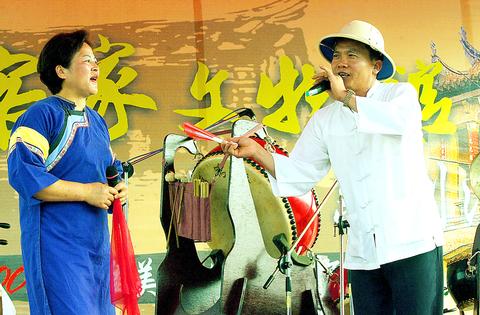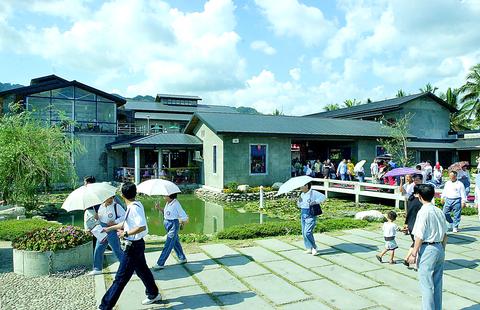Its been nearly seven years, but finally the NT$120 million Hakka museum in Meinung township officially opened yesterday in a colorful ceremony at which President Chen Shui-bian (陳水扁) put in an appearance. Hakka culture, like many other minority cultures around the world, is receiving greater recognition by government agencies, and while this museum is far from the first to be devoted to Hakka culture, it is remarkable for its effort to become an integral part of the Hakka community in Meinung.
President Chen used the opening of the museum to emphasize the government's efforts to preserve Hakka culture and give it the recognition it deserves. Hakka people represent about 15 percent of Taiwan's population, and in townships such as Meinung, Hakka people make up over 90 percent of residents. The Hakka, who traditionally have emphasized education even more than most Chinese, are disproportionately represented in the upper levels of academia and government, and current legislation is being reviewed that will create a central government agency for Hakka affairs.

PHOTO: CHEN CHENG-CHANG, TAIPEI TIMES
The museum, designed by the Hakka architect Hsie Ying-jun (謝英俊) is a modernized representation of a traditional tobacco smoke house. These buildings, which used to dominate the landscape in Meinung, have now largely fallen into disrepair, as the government tobacco monopoly has reduced its purchases of local product. Nevertheless, smoke houses are a potent symbol of Meinung, for it was the tobacco industry which provided the economic foundations for earlier generations of highly-educated Hakka people.

PHOTO: CHEN CHENG-CHANG, TAIPEI TIMES
A number of smoke houses have been converted to recording studios, the best known of which is probably the one owned by Labor Exchange (交工樂隊), a local folk rock group.
Wang Hsiu-mei (王秀美), who has worked with the museum over the last three years in its preparation phase, said that an important aspect of the museum's concept is as a community museum. The exhibits, dedicated to all aspects of daily life in Meinung, has a slight feel of a beleaguered community protecting its identity, not that this makes the show any less interesting.
Margaret Wang (王長華), director of the Kaohsiung City Government's Cultural Bureau and head of the museum, pointed out that the Hakka of Meinung, with their almost obsessive respect for education and the written word, have maintained exhaustive records of their community, providing a uniquely solid foundation for the work of cultural preservation. Unfortunately, it is this emphasis on the written word that makes the museum hard going, and tends to emphasize its role as a cultural preservation project. But for those with the time and inclination, the combination of audiovisual elements, with extensive texts and photographic material, along with a comprehensive collection of local publications on Hakka culture, make it an invaluable resource.
The museum's association with Meinung differentiates it from other Hakka cultural centers around the island. "The Taipei and Kaohsiung Hakka cultural centers are cultural facilities forcibly grafted into an alien environment," Margaret Wang said. "Here we are an organic part of the environment."
The museum is located among uncluttered fields, and provides a focus for the scattered tourism attractions of the Meinung area, such as old smoke houses and Butterfly Valley (黃蝶翠谷). "We hope it will serve the role of an information center for the area," Margaret Wang said. Another role the museum aims to play is that of a Hakka community center, were Hakka people will have a chance to get in touch again with their culture.
Although currently operated by the Kaohsiung County Cultural Bureau, Wang said that consideration is already being given to handing the venue over to private interests in the next few years in line with a government policy of localization in which communities take on an increasing responsibility for their cultural and tourism resources.
What: Kaohsiung County Meei-nong The Hakkas Museum (高雄縣美濃客家文物館)
Where: 49-3, Minchu Rd., Meinung Township, Kaohsiung County (高雄縣美濃鎮民族路49之3號)
Open: 10am to 4pm (closed Monday and public holidays)
Free entry.
On the Net: http://www.kccc.gov.tw

This is the year that the demographic crisis will begin to impact people’s lives. This will create pressures on treatment and hiring of foreigners. Regardless of whatever technological breakthroughs happen, the real value will come from digesting and productively applying existing technologies in new and creative ways. INTRODUCING BASIC SERVICES BREAKDOWNS At some point soon, we will begin to witness a breakdown in basic services. Initially, it will be limited and sporadic, but the frequency and newsworthiness of the incidents will only continue to accelerate dramatically in the coming years. Here in central Taiwan, many basic services are severely understaffed, and

Jan. 5 to Jan. 11 Of the more than 3,000km of sugar railway that once criss-crossed central and southern Taiwan, just 16.1km remain in operation today. By the time Dafydd Fell began photographing the network in earnest in 1994, it was already well past its heyday. The system had been significantly cut back, leaving behind abandoned stations, rusting rolling stock and crumbling facilities. This reduction continued during the five years of his documentation, adding urgency to his task. As passenger services had already ceased by then, Fell had to wait for the sugarcane harvest season each year, which typically ran from

It is a soulful folk song, filled with feeling and history: A love-stricken young man tells God about his hopes and dreams of happiness. Generations of Uighurs, the Turkic ethnic minority in China’s Xinjiang region, have played it at parties and weddings. But today, if they download it, play it or share it online, they risk ending up in prison. Besh pede, a popular Uighur folk ballad, is among dozens of Uighur-language songs that have been deemed “problematic” by Xinjiang authorities, according to a recording of a meeting held by police and other local officials in the historic city of Kashgar in

It’s a good thing that 2025 is over. Yes, I fully expect we will look back on the year with nostalgia, once we have experienced this year and 2027. Traditionally at New Years much discourse is devoted to discussing what happened the previous year. Let’s have a look at what didn’t happen. Many bad things did not happen. The People’s Republic of China (PRC) did not attack Taiwan. We didn’t have a massive, destructive earthquake or drought. We didn’t have a major human pandemic. No widespread unemployment or other destructive social events. Nothing serious was done about Taiwan’s swelling birth rate catastrophe.